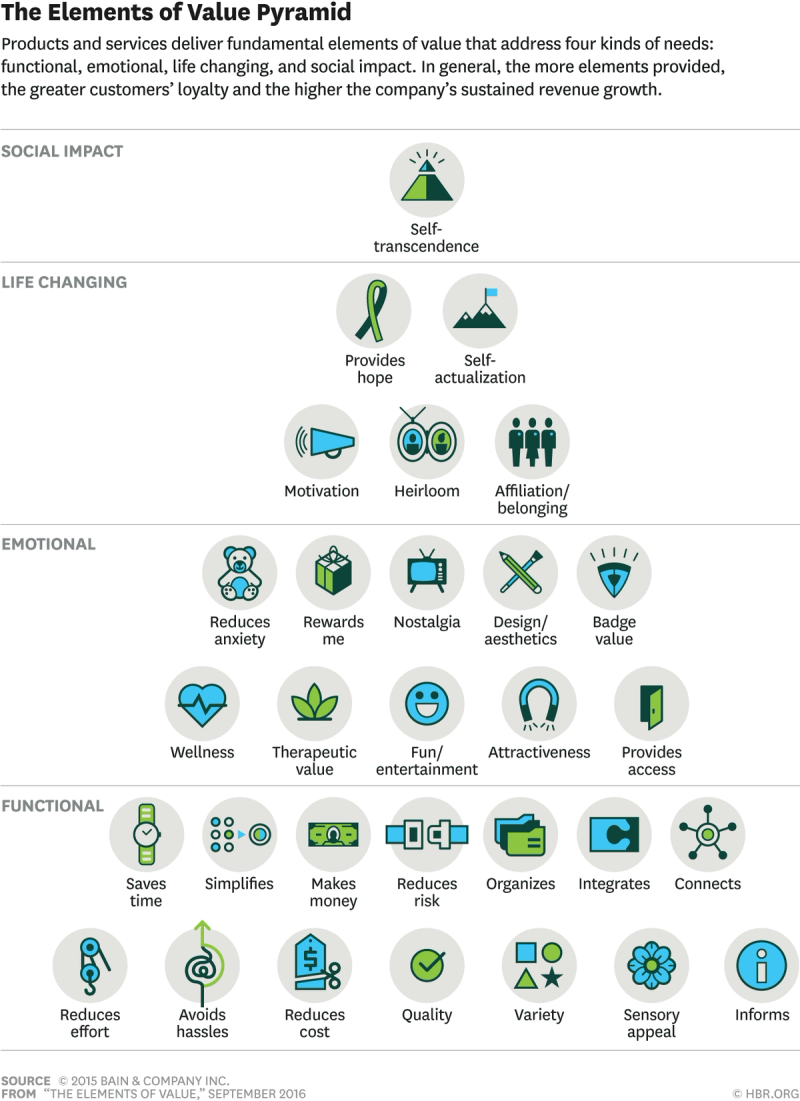The Power of Marketing Value Over Features for SaaS

In today’s crowded SaaS landscape, simply listing features is no longer enough to differentiate a brand or product. Modern consumers are searching for solutions that do more than just meet technical requirements—they want products that fulfill deeper emotional, functional, and even societal needs. Here, the Elements of Value pyramid by Bain & Company offers a powerful framework that helps SaaS marketers move beyond features to communicate the real value of their offerings. Let’s explore how focusing on these elements of value can transform your marketing strategy and drive lasting customer engagement.
What is the Elements of Value Pyramid?

The Elements of Value pyramid categorizes 30 fundamental needs that products and services can meet. These needs are grouped into four layers: Functional, Emotional, Life Changing, and Social Impact. Each layer builds on the previous one, creating a hierarchy of value that resonates with customers at different levels. In SaaS, we often concentrate on functional aspects, but understanding and incorporating higher-level elements can be the key to standing out.
1. Focusing on Functional Elements
Functional elements are foundational for any SaaS product. They address essential needs, like:
- Saves Time: SaaS products that help users automate tasks or reduce manual work can emphasize this value.
- Reduces Cost: Budget-conscious customers want to know if your software can reduce their spending.
- Quality: High performance, reliability, and robust support can help communicate this.
For instance, a project management tool could emphasize how it “saves time” by integrating workflows, automates routine tasks, and provides high-quality reports, helping teams be more efficient.
However, merely focusing on functional benefits can make your brand sound like every other tool in the market. It’s necessary to communicate additional layers of value to connect more deeply with customers.
2. Building Emotional Connections
Emotional elements resonate on a personal level, creating a sense of loyalty and preference beyond functional needs:
- Reduces Anxiety: SaaS platforms that promise ease of use, strong security, and dependable customer support can reduce anxiety. Consider marketing copy that emphasizes “peace of mind.”
- Therapeutic Value: Products that simplify complicated processes, like tax software, offer emotional relief. This could be highlighted with testimonials or case studies that show customers’ improved workflows.
- Attractiveness: A well-designed, intuitive interface can be marketed as “user-friendly” and “beautifully simple,” appealing to customers’ appreciation for good design.
A CRM software, for example, could appeal to potential users by showcasing its ability to “reduce anxiety” through robust data security features and 24/7 customer support.
3. Elevating with Life-Changing Elements
Life-changing elements address personal transformation, positioning the product as something more than just a tool—it’s a partner in growth:
- Motivation: SaaS tools that encourage personal productivity and growth, like time management or educational platforms, can use motivational messaging.
- Self-Actualization: When a product helps users achieve their highest goals, it transcends its functional purpose. A productivity app that enables users to become “their most productive selves” speaks to this element.
SaaS brands can go beyond practical benefits by showcasing success stories and the personal transformations users experience. This is especially relevant for products designed to improve career skills, wellness, or personal development, as they naturally align with users' goals of self-betterment.
4. Making an Impact with Social Value
At the top of the pyramid lies social impact, where products support higher values and create a broader sense of purpose:
- Self-Transcendence: Some SaaS companies embrace missions that are larger than themselves, such as sustainability or social good. Communicating how your software contributes to positive social impact can resonate with customers who prioritize values over features.
For example, if your SaaS product supports remote work and helps businesses reduce their carbon footprint, this element can be highlighted as part of a mission to build a more sustainable future.
Applying the Elements of Value in SaaS Marketing
Here are some practical steps to bring the Elements of Value into your SaaS marketing:
- Identify Core Elements for Your Product: Determine which elements best fit your SaaS product. Not every element needs to be addressed—focus on those that align with your brand mission and user needs.
- Craft Value-Driven Messaging: Develop messaging that moves beyond functionality to address emotional, life-changing, or societal impacts. Customer testimonials, case studies, and social proof are valuable here.
- Use Visual and Narrative Storytelling: Humans are hardwired for stories. Share success stories or scenarios where users gain peace of mind, achieve self-betterment, or contribute to a larger cause through your software.
- Engage at Multiple Levels: To build a deeper connection, ensure that your SaaS marketing covers different levels of the pyramid. For instance, a cloud storage tool could advertise not just its high security and easy access (functional), but also its potential to “reduce anxiety” about data loss (emotional) and contribute to a “more sustainable world” by reducing paper use (social impact).
The Elements of Value framework offers SaaS marketers a roadmap for connecting with customers in a way that goes far beyond features. By addressing needs at multiple levels—functional, emotional, life-changing, and social—your SaaS product becomes more than just software; it becomes an essential part of the user's life and values. In a competitive market, this depth of connection can be the difference between a one-time user and a lifelong advocate.